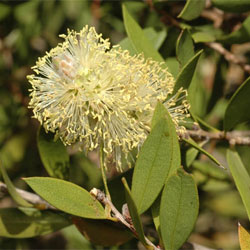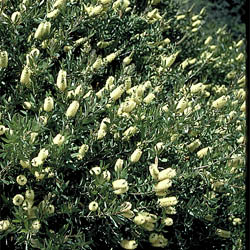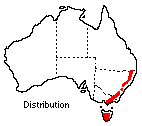Callistemon pallidus
 |
 |
Some herbaria use the name Melaleuca pallida
Lemon Bottlebrush
Callistemon pallidus (Bonpl.) DC.
Melaleuca pallida (Bonpl.) Craven
There are forty species in the genus Callistemon which is included in the family Myrtaceae. These distinctive plants which are commonly called 'bottlebrushes' are a familiar sight in many gardens and there is always a place for one of them. Recent research has suggested that the genus Callistemon should be included within the much larger genus Melaleuca, and some herbaria are accepting this for their classification.
Callistemon pallidus, commonly called Lemon Bottlebrush, is a widely grown ornamental plant which has performed exceptionally well in cultivation and is useful as a specimen or screen plant.
It is an upright hardy shrub with slender spreading branches growing to a height of 3 m by 2 m across. The fresh lemon coloured brushes present a pleasing contrast to the grey-green foliage. This frost-hardy plant will grow in moist situations in full sun or part shade and will withstand moderate exposure to salt laden winds.
 Callistemon pallidus is common on rocky sites of the eastern ranges
and occurs naturally in New South Wales, the Australian Capital Territory, Victoria
and Tasmania. In the ACT it is a dominant species in heath on exposed mountain
slopes.
Callistemon pallidus is common on rocky sites of the eastern ranges
and occurs naturally in New South Wales, the Australian Capital Territory, Victoria
and Tasmania. In the ACT it is a dominant species in heath on exposed mountain
slopes.
The leaves are tapered to 50 mm long and dotted with oil glands. Young growth is often attractively covered with dense silky hairs, later becoming smooth. The flowers are borne in profuse cylindrical spikes 50-100 mm long and occur from September to January. Individual flowers have 5 sepals, 5 petals and numerous cream to greenish-yellow stamens. The cup-shaped fruit capsules are woody and contain numerous fine seeds.
Callistemon pallidus may be propagated from seed or cuttings. When collecting seed, select old capsules and place them in a warm area until they dry out and release the fine seeds. New growth which has hardened is suitable cutting material and should be taken in February/March. Cuttings should be treated with a rooting hormone.
This plant responds well to periodic pruning to encourage a bushier growth habit. Mulching and the application of a complete fertiliser in spring and autumn are recommended.
Some cultivars of C. pallidus have been introduced into cultivation. These include Callistemon pallidus 'Austraflora Candle Glow' which has a low spreading habit and lemon brushes 75-100 mm long and Callistemon 'Clearview Father Christmas' which has flower spikes 110 mm long with whitish stamens and red anthers.
Text by Effie Mullins, ANBG (1989)
Name meaning: Callistemon pallidusCallistemon - from two Greek words, kallistos, most beautiful, and stemon, a stamen; pallidus - Latin, pale, referring to the light-coloured inflorescences. |
![An Australian Government Initiative [logo]](/images/austgovt_brown_90px.gif)

